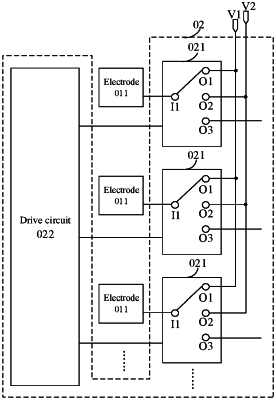| CPC B01L 3/50273 (2013.01) [B01L 3/502715 (2013.01); B01L 3/502784 (2013.01); B01L 2300/0816 (2013.01); B01L 2400/0415 (2013.01)] | 20 Claims |

|
1. A method for driving a microfluidic chip, applicable to a device for driving a microfluidic chip, wherein the microfluidic chip comprises a droplet and a plurality of electrodes; the device for driving the microfluidic chip comprises a plurality of switch circuits one-to-one corresponding to the plurality of electrodes, each of the switch circuits having an input connected to the electrode corresponding to the switch circuit, and outputs connected to a first power supply and a second power supply respectively; and the method comprises:
controlling, by a first switch circuit in the plurality of switch circuits, a first electrode connected to the first switch circuit to be electrically connected to the first power supply with the second power supply being disconnected, the first electrode being an electrode currently carrying the droplet;
after controlling the first electrode to be in electrical connection to the first power supply for a first period of time, controlling, by the first switch circuit, the first electrode to be electrically connected to the second power supply with the first power supply being disconnected, and controlling, by a second switch circuit connected to a second electrode, the second electrode to be electrically connected to the first power supply, such that the droplet moves onto the second electrode, the second electrode being an electrode adjacent to the first electrode; and
after controlling the first electrode to be in electrical connection to the second power supply for a second period of time, controlling, by the first switch circuit, the first electrode to keep disconnected from both the first power supply and the second power supply respectively, such that part of unreleased charges remains on the first electrode.
|